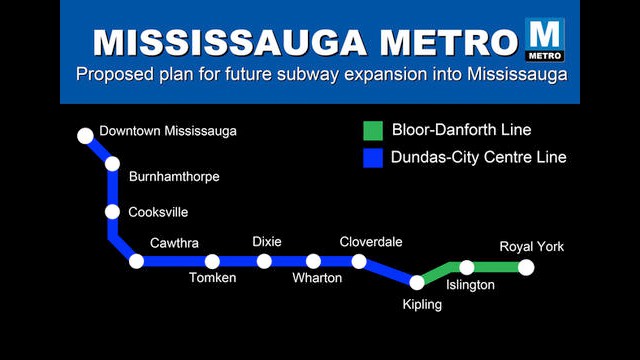It’s Time to Build a Subway to Square One
Published March 25, 2015 at 6:29 pm

Mississauga is becoming a big city and it needs to start making big city investments. A city is defined by its investments in infrastructure.
It’s time for the City of Mississauga to start investing for success and extend the subway from Kipling Station to Square One. Investing in a subway is a right of passage for Mississauga to becoming a big city.
Despite repeated prods from the Province over the past 35 years to invest in a subway, Mississauga has chosen instead to invest in cheaper projects. Mississauga should not settle for cheaper suburban transit alternatives such as the Mississauga Transit Way. We need to build for the future, not just serve what we have today. When again will we get a chance to shape the City if we settle for the status quo? We don’t want to make the mistakes Toronto made by under investing in transit for 40 years.
Currently, the City of Mississauga is waiting for a 100% funding commitment from the province to fund Light Rail Transit (LRT) on Hurontario Street. Having played a small role in the initial planning and design work for the LRT, I don’t want to be overly critical of the plan. I just don’t think it is going to unlock the economic potential of Mississauga the way people think it will. A subway linking Kipling station with Square One, (running along the Dundas Street and Hurontario Street corridors) will provide a transit spine for Mississauga that will deliver seamless and convenient travel between Mississauga and Toronto, and help alleviate congestion between and within both cities. Buses, BRT and eventually LRT, can feed the transit spine. It will elevate Mississauga’s city-building and economic development potential and will be a key ingredient to growing jobs and igniting office development in Mississauga, particularly in the downtown.
As the City of Mississauga awaits a funding announcement on LRT, I believe that the required $1.6 billion investment for LRT would be better spent on a subway. At a cost of approximately $300 million per kilometre to build a subway, $1.6 billion would essentially pay for a subway from Kipling to Hurontario Street, (almost half of the total 12.2 kilometre line). This assumes expensive tunnel boring is required; however, given the wide rights of way on both Dundas Street and Hurontario Street, it may be possible to use an open dig method, which could substantially reduce costs.
The Dundas corridor is targeted for intensification and subways add tremendous value to adjacent land, by capturing 10% of the increased value in partnership with landowners, $1.6 billion can be generated and directed towards capital construction costs. The remainder of the subway can be financed through a partnership with the City of Mississauga, Federal Government, Provincial Government and Region of Peel.
Intensification, that will accompany the subway, will also benefit the City by providing an increased assessment base that will deliver increased revenues to the City in perpetuity. From an operational perspective, I would be very supportive of Metrolinx owning and operating the line. I believe it is very appropriate for the transit arm of the province to be overseeing the operations of cross-border higher order transit.
There is a realistic and achievable funding plan to make this happen. Residents are telling me that after 35 years it’s time to deliver what they really want – a subway to Square One. This is not about subway versus LRT, versus BRT. A big city needs a connected network of various rapid transit options. To set Mississauga up for success and catalyze real city building, the priority should be to focus our energy on the creation of the transit spine that everyone wants – a subway. Then, once the spine is in place, we can look at the various options to connect with and feed the spine. It just makes common sense.
The City of Mississauga is anticipated to have twice as many people living and working in our city than the City of Vaughan by 2031. Vaughan’s subway is anticipated to open by 2017. Why is Vaughan being treated as more important than Mississauga?
insauga's Editorial Standards and Policies advertising






